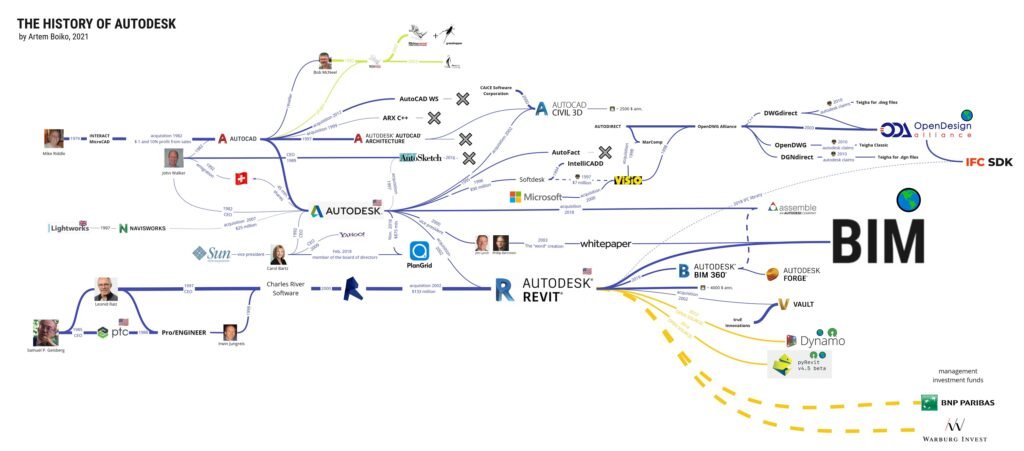Lobbyist Wars and BIM Development. Part 4: The fight between CAD and BIM. Monopolies and lobbyists in the construction industry.
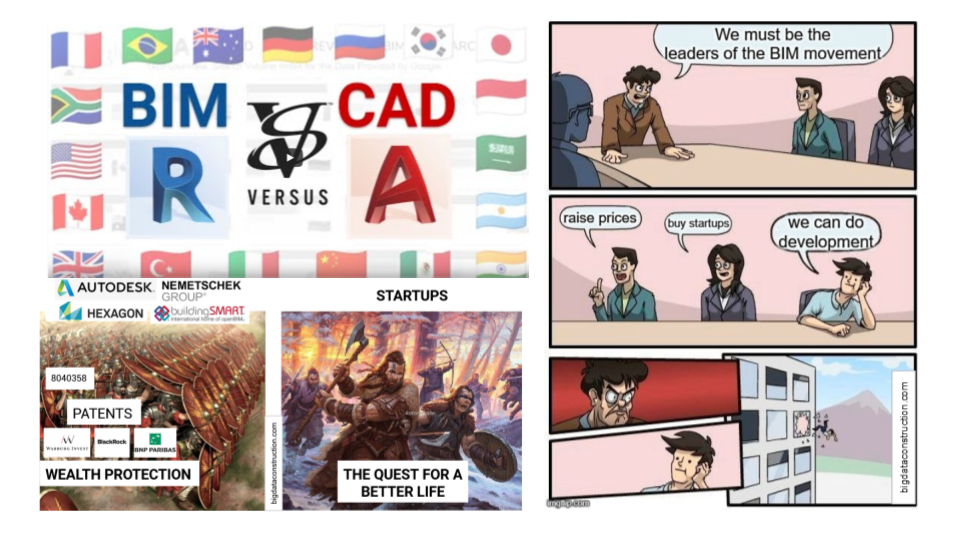
In the last article: Part 3: The Fathers of BIM Technologies. Who is behind the success of Autodesk and openBIM was shown how all the BIM tool development teams are connected to each other and how each development team, borrowing ideas from each other, tried to make its own unique BIM program. At the same time, almost all significant ideas or developments were not created by large corporations: Autodesk, Nemetschek Group, or Hexagon simply bought startups on time from disgruntled former employees of their competitors.
Corporations are only engaged in product support and promotion, while small startups are engaged in the development and creation of breakthrough ideas.
🙋🏼♂️ Thank you very much to everyone who left their comments and criticism under the previous articles. Special thanks to Dainius Gudavicius for buying coffee and supporting content. Also thanks to everyone who shared the information that was touched upon in the first parts, and to those who wrote me private messages:

Thanks for your feedback. Thanks to your criticism and your additions, the BIM history map looks more complete (now there is a version number and a date next to the name of the map to make it easier to track changes, and current prices for using software licenses 👨💻 have been added).
Also, now this map is available for commenting: to add a comment to this diagram or to examine in more detail individual fragments of the map, follow the link: BIM Development Map from 1980 to the present
If you have information on the events that were described in the previous parts, or if you want to express your criticism – please write to me.
In this part we will talk about the struggle between CAD and BIM, about the monopolization of construction design by Autodesk and the buildingSMART organization, and about lobbying for the openBIM concept at the state level in some countries.
The beginning of the struggle between CAD and BIM. Prologue.
Everything that is connected with BIM technologies today came to us from the CAD world of the 80s, when only CAD technologies were used in design. The largest CAD software manufacturers in the 80s created slow and clumsy software in outdated programming languages – Fortran and assembler: IBM / Dassault (CADAM and CATIA), Computervision (CADDS), SDRC (I-DEAS and Intergraph (IGDS and InterAct). All of these corporations in the early 90s rejected Samuel Geisberg’s ideas for the development of new tools in design as uninteresting and no future technology. More on this in the third part.
But within a few years, from 1988 to 1990, the PTC team led by Geisberg managed to completely change the approach to design and engineering around the world for several decades to come. Using solid parametric modeling with the concept of a single model, PTC’s Pro / Engineer becomes the first 3D CAD / MCAD program to almost completely (apart from drawing with a pen) implement the ideas first demonstrated by Ivan Sutherland’s Sketchpad in 1962. And by the mid-90s, Pro / Engineer was irrevocably changing the way CAD users think about interfaces, ease of use, and speed of solid design.

The same revolution in the design market in the construction industry, which would later receive the name BIM, was carried out 10 years later by Geisberg’s student, a graduate of Leningrad University – Leonid Raits, who, 10 years after emigrating from the Soviet Union, his former mathematics teacher – Geisberg – in 1986 one of the first employees to his new company PTC. For several years, by 1988, under the leadership of Geisberg, Reitz created the geometric kernel for the Pro / Engineer program.
Autodesk discovers BIM
2002 is considered the year of birth of a new ideology invented by Autodesk Corporation – Building Information Modeling – BIM.
On wikipedia’s BIM page:
In 2002, Autodesk released a white paper entitled “Building Information Modeling, and other software vendors also started to assert their involvement in the field”.
Until 2002, Autodesk itself, without significant success (as often happens with large bureaucratic organizations), by its internal developers, tried to create a 3D CAD replacement for its only successful AutoCAD product, which was “bought” in 1982 from Mike Riddle and on which John Walker ( the future first CEO of Autodesk) was able to build a successful business model for the sale of licenses – Autodesk.
In 1992, John Walker handed over the management of the company to a new CEO – Carol Bartz, received a $ 42 million stake in Autodesk and emigrated to Switzerland.
From that moment on, if you look at the annual reports of Autodesk Corporation from 1992 to 2002, one gets the impression that after leaving Mike Riddle (the creator of AutoCAD), the only product other than AutoCAD that Autodesk developers were involved in and which today still remains in the design market was AutoCAD Architectural Desktop (which the corporation itself is trying not to mention today).
Also during this period, Autodesk tried to remove from the market its potential competitors, such as VersaCAD, IntelliCAD, AutoSketch, buying out startups and fighting in courts for patents and licenses, in order to prevent these startups from being sold to competitors.

But what did Autodesk discover that in 2002 it sharply became the leader in 3D BIM design, publishing a white paper about BIM, which will start a new era in the world of design?
Specifically in 2002, Autodesk buys the startup Revit of Leonid Raits, and it is in the pre-sale presentations of Leonid Raits, which were created for negotiations with Autodesk, that it is logical to look for the source of the white paper BIM, released a year after the sale.
For 6 years, the Revit development team has created a radically new approach for CAD software for construction from scratch: with parametric modeling and the concept of a single data model for the entire project, developed by Samuel Gaisberg and Leonid Raitz back in 1988 for the Pro / Engineer program.
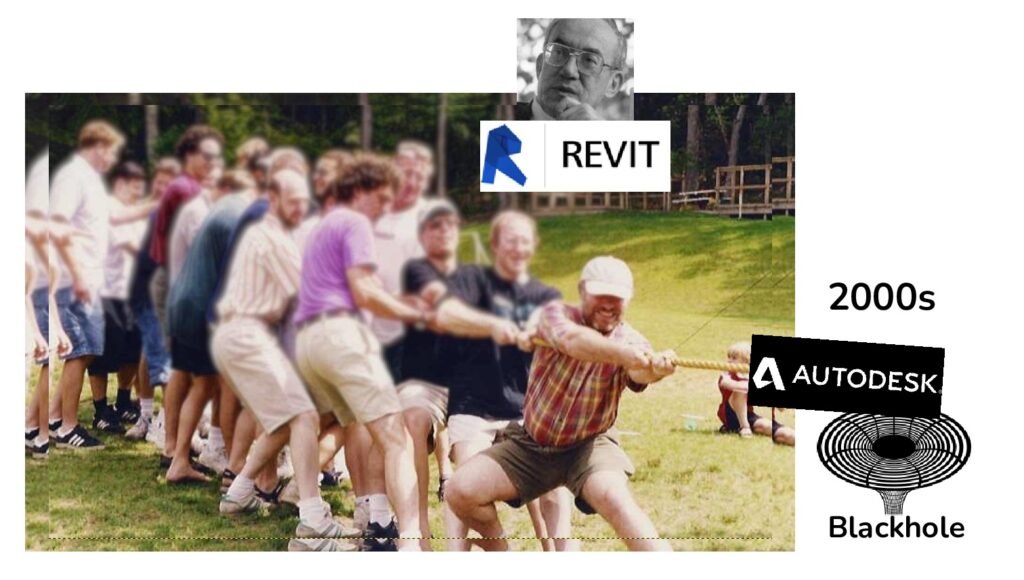
After a failed attempt by Autodesk to buy Solidworks (a copy of the Pro / Engineer program), after the unsuccessful pursuit of IntelliCAD developers, in 2001 – after the purchase of Revit – Autodesk CEO Carol Ann Bartz, not expecting a significant profit from this next startup, describes Revit as “small experimental user base”.
At that time, she already suspected which product Autodesk received for only $ 130 mln $ and that Leonid Raitz was behind not only PTC developments, but also Samuel Gaisberg himself, who gave life to such programs as Solidworks and Digital Project (for comparison, in 2018 year Autodesk paid for Plangrid: startup applications for the tablet – $ 875 mln. One of the main founders of this startup was the former CEO of Autodesk – Carol Ann Bartz).
In the 2000s, the new Digital Project program, a mixture of the development of SolidWorks, Catia and Frank Gehry, was used in their work by many architects and Prizker Prize winners, including Zaha Hadid with her famous curves and cosmic forms of buildings, which after 2005 became more like for engineering projects.

Thus, the technologies used in Revit and available to the mechanical engineering industry since the early 90s, only 10 years later, by the early 2000s, finally reach the largest ecosystem in the world – the construction industry.
Expansion of BIM ideology and Revit software
In 2002, after purchasing Revit, Autodesk finally discovered the world of parametric 3D solid modeling – a technology that eluded Autodesk in the late 90s due to the refusal of the Solidworks developers to sell their company at the Autodesk “hard price” (in 1997 Solidworks for 310 mln $ still goes to the French corporation Dassault Systemes).
And a year later, two vice-presidents of Autodesk – Phil Bernstein and Jim Lynch – release White Paper – Building Information Modeling (which was most likely copied from the presentations of the Revit developers) and open BIM ideology to the whole world.
From this moment, from 2003, the countdown begins for a new ideology that has captured the entire construction world for the next twenty years – BIM.
How has the struggle between CAD and BIM been going on since Autodesk proclaimed the arrival of a new era of BIM, or, more precisely, how has Revit technologies been expanding in construction design around the world since 2003?
Thanks to Google’s open search data, we can now trace this CAD versus BIM rivalry over the years. Let’s look at the development of the popularity of CAD and BIM design in the G20 countries (The Group of Twenty, major advanced and emerging economies) from 2004 to 2020.
I have identified 4 main, most popular, search queries that have been important in the field of design and planning since 2003:
- “AutoCAD” – the main program for designing and creating 2D drawings
- “Revit” – a young program from mechanical engineering with new parametric modeling and a single project model
- “Archicad” is the main representative of the openBIM concept, in 2000 the only worthy representative of 3D design with visualization
- “BIM” – a request for this phrase shows interest in the BIM topic in relation to other requests that worried designers in the period from 2003 to 2020

Open data on search queries and real interest in a particular product or product may often be unrelated to each other, for example, if this product is sold mostly offline (without using the Internet). But if we are talking about programs and digital products, then, of course, the interest in the product in the search can be relatively judged by the general interest in the product and its sales. Objective Google Trends indicators for each query show the relative popularity of the query: 100 points mean the maximum interest in the topic, and 0 means insufficient information on it.
In the following video, I have collected data on the interest in queries: “Autocad, Revit, Archicad, BIM” in each of the G20 countries from 2004 to 2020.
According to the data presented in the video, it can be seen that since the start of sales of Revit, which marked the White Paper BIM, interest in obsolete CAD technologies in the world begins to wane. The main conclusions that can be drawn from the obtained data:
- BIM broke AutoCAD’s dominance in the world in 2020 thanks to the COVID-19 crisis. Congratulations to us all 🍾🎉. It can be assumed that now the development of the AutoCAD product will be paused and the AutoCAD team will be engaged in the next 10 years only with the support of the product.
- In English-speaking countries (USA, Canada, Australia, UK, South Africa), interest in the BIM topic (more precisely, in the BIM technologies and ideas used in the Revit program) by the beginning of 2021 wins the 2D design technology using AutoCAD
- European countries are actively interested in the BIM topic, but, unlike English-speaking countries, they do not want to completely become dependent on Autodesk corporation, seeking to support local CAD software manufacturers who are trying to work on the openBIM concept
- South America (excluding Brazil) and Asia (excluding China) are just beginning to show interest in using BIM technologies and are starting to invest their time in these new hype technologies.

Additional insight on this data: on big national holidays such as Christmas and New Year (December 2020 in the video – holidays and lockdown) in many countries, requests for an AutoCAD product are one month behind interest on the topic of BIM and Revit. People on holidays, disconnected from work processes, willingly master a new topic – BIM and Revit.
According to search data, we can say that interest in AutoCAD, that is, in 2D design, will continue to decline. Most design companies will move to the more advanced Revit, just as in the 90s all the major engineering companies in the world massively transferred their design to PRO / Engineer.
But, unfortunately, Revit is not the locomotive of Autodesk Corporation that can pull the entire business model.
Revit is a dead-end road for Autodesk
As the 40 years of Autodesk’s existence show, developers from Silicon Valley during this time have not been able to independently make new breakthrough products in any of the CAD and BIM areas. Almost all Autodesk software was bought from the startup market in the 90s and 2000s. And a few years after buying these startups “at a hard price” the creators and core developers left Autodesk.
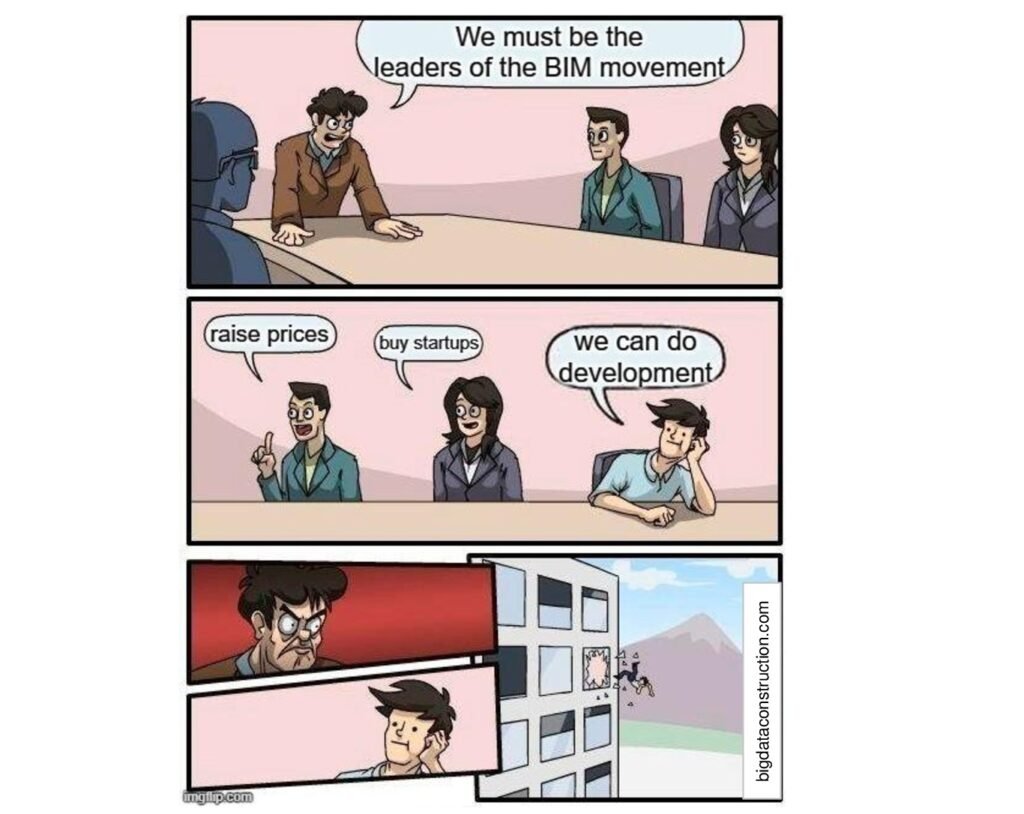
Likewise, the creator of Revit, Leonid Raits, who himself had nothing to do with construction, left Autodesk in 2004 and after selling his startup he himself became a venture investor. And although Autodesk begins to generate billions in revenue from Revit licenses, active development of the program after the departure of the creators of Revit has been slowed down, and since that moment, there have been no big innovations and the development of new tools for the work of architects and designers.
By 2020, Autodesk’s misunderstanding of the basic requirements of the construction industry has reached such a level that, out of desperation, global architectural firms are beginning to send open letters to the almighty Autodesk Corporation. An example of an open letter dated July 2020, signed by the largest architectural firms in the world, including the previously mentioned bureau Zaha Hadidis.
In this letter, the largest design bureaus in the world write that over the past 20 years, Autodesk programs have hardly had major innovations and the performance of Revit today does not meet the growing needs of projects (becoming more detailed every year). Also in the open letter, it is said that due to fear of Autodesk, not all companies decided to put their signatures on this appeal.
Thus, not seeing any progress in development and some changes since the early 2000s, the largest customers of Autodesk, under pain of price reprisals from the corporation, in despair turn to the creator of the BIM movement in the hope that Autodesk will finally address the issues of creating more modern , fast and easy-to-use tools, unaware that Autodesk is unable to “independently” develop new tools.
History (more in Part 3: Fathers of BIM Technologies. Who Is Behind the Success of Autodesk and openBIM) shows that it is useless to turn to well-fed and wealthy corporations for new technologies. All disruptive technologies and startups are driven forward only by dissatisfied and hungry developers.

There are many good things to say about Autodesk, but you can also notice that over 40 years Autodesk has gradually become a follower of the principles of dictatorship with the creation of ideologies and the persecution of dissent:
- those who are not ready to adjust to Autodesk are subject to price repression;
- the majority of designers are completely dependent on Autodesk products and practically cannot use (or with difficulty, through IFC crutches) other programs;
- Autodesk almost does not develop new products and increase productivity of existing programs;
- Autodesk eliminates competitors by buying startups and blocking patents through the courts and further developing competitive products.
- the main forces and investments of the corporation go to support the product, the massive purchase of technologies and the expansion of ideology to other countries;
- Autodesk gathers startup developers under its wing, who, having received monetary freedom, immediately flee the corporation;
“The rulers need to experience cold and hunger, this is the only way they do not forget about their people.”
Dmitry Ignatov
In general, in Autodesk politics can be observed not democratic centralism own ideology.
But still, some small incentive for development remained with Autodesk. This is a small opposition to the ideology of closedBIM with openBIM in the east – in some countries of Europe and Asia.

This artificial conflict of ideologies “accidentally” gave itself, Autodesk, creating (simply register on its name) in the mid-90 to exit from the 2D world 3D design format IFC and cartel organization IAI. More on this in the third part.
Maybe openBIM is the life-saving alternative that can fight back Autodesk’s price hikes every year ?!
Is openBIM a worthy Revit alternative?
The only alternative to Revit today is a zoo of programs that work on the openBIM principle – through data exchange in the IFC format.
According to the open search data presented in the second part, it can be seen that only a few countries (Kenya, Romania, Austria, Switzerland and Germany) stand out all over the world that use the openBIM concept for design in their construction industry.
These are mainly German-speaking countries. And the main leader of the entire openBIM movement in Europe is logically the Nemetschek Group with two products: Allplan and Archicad. They may already be on the verge of extinction, if not the IFC format, which is now at the time of saving the business model of European corporations.
The IFC format is a product developed by the University of Munich team (and later registered with Autodesk Corporation). Since 1997, it has been controlled by a cartel of CAD software manufacturers and other corporations interested in setting their standards around the world. At the head of this entire organization is the main committee of this socialist ideology – buildingSMART International.
What is the IFC format on which the whole openBIM concept is built? (more about the creation of IFC in the third part):
- IFC is an ordinary PDF format, only slightly more intelligent
- IFC format is not a data exchange format for further editing
- The IFC is not possible to put the drawings in conjunction with a single model
- The project model itself or any element in the IFC format is not suitable for continuing work on them
That is, after importing an IFC file into any BIM program, it cannot be edited or supplemented. And if you still want to do it (and you want to do it), the best solution would be a complete reconstruction of the geometry in the program in which you work, while the work is similar to copying the pattern (IFC model) using a light table along the bold lines of the original drawing.
What is IFC for then? You will only need this format if you cannot collaborate on sections of the project with other firms that prefer to use local software. You will also have to export the model in IFC format if your customer needs the entire project in IFC format. But the problem in the case of export / import from different programs is that when you import IFC, you often get a product of low quality.
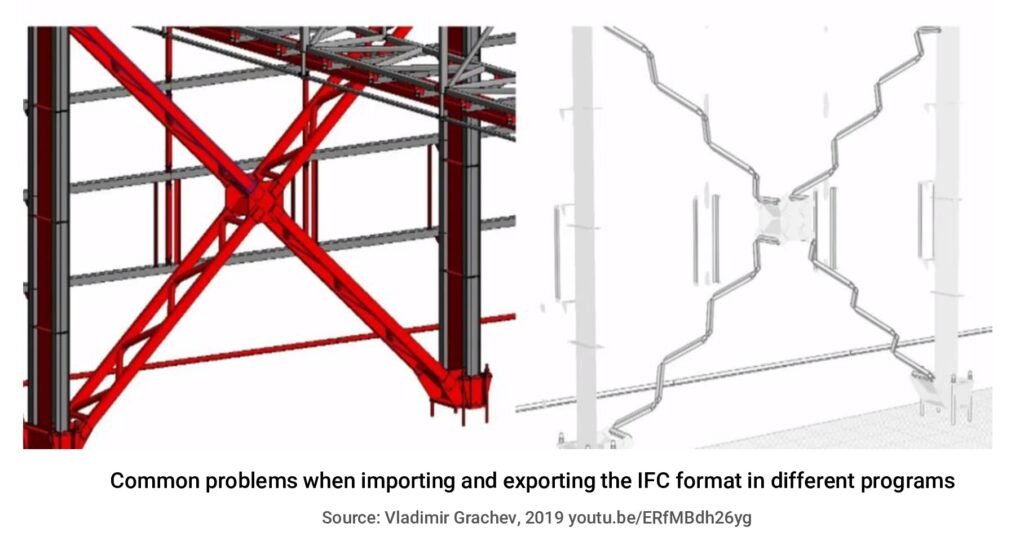
In general, working with the IFC format in a multi-vendor environment is often simply inconvenient, and in order to set up the process of importing and exporting the IFC format, you will need enthusiasm, ingenuity and free time.
A good proof of this is a survey carried out by the German Federal Ministry for Transport, Construction and Urban Development (Bundesministerium für Verkehr, Bau und Stadtentwicklung) among BIM professionals in 2013.
To the question “Does the IFC exchange format match the content and your formal requirements for the exchange of model data?” more than half of the surveyed BIM specialists answered that the IFC format meets their requirements by less than 25%.
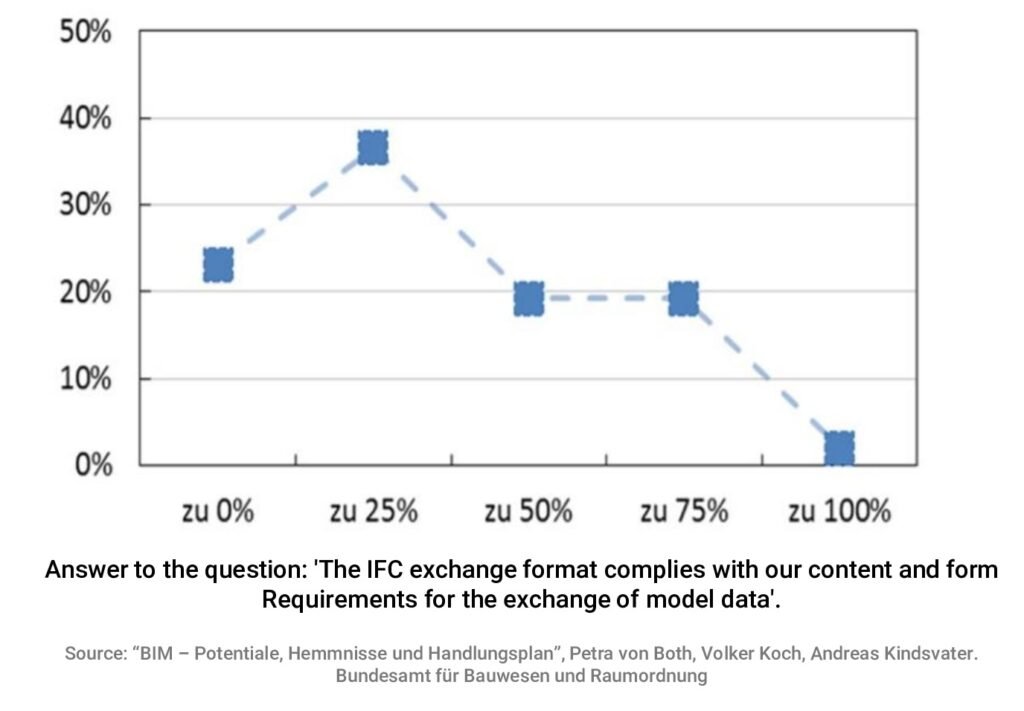
Therefore, companies that are today considered leading in the development of BIM technologies in Germany, such as Max Bögl, Goldbeck, Hochtief, after their unsuccessful experience with different formats and import / export problems, are switching to full cycle design based on the closedBIM concept in the Revit program.
If ministries receive such research and feedback on the “difficult” work on the openBIM concept, why then do many companies in Germany continue to insist on the promise of these approaches, and why did German-speaking countries choose this not the easiest path?
Why did German speaking countries choose the openBIM path?
To understand this logic, for this we will once again turn to the history of the creation of the openBIM concept. In 1995, Autodesk took the development of the University of Munich IFC format and created on its basis a new direction for its business model, under which the cartel organization IAI – the Industrial Alliance for Interoperability – was created. Two years later, already in 1997, Autodesk transferred the theme from the American continent to an international scale and renamed the “Industrial Alliance for Compatibility” into “International Alliance for Compatibility” (where again an attempt to create a new world ideology begins to flicker in the name).
But, as usual, Autodesk did not manage to come up with anything with the IFC format and by the beginning of the 2000s, general interest in the IAI organization began to wane. Until now, Autodesk products, through inattention or by design, hardly work with the IFC format, but the truth has recently sharply changed its mind and even parisjoined to its main enemy, the ODA organization – about this in a little more detail in the next part. Autodesk itself, having finally successfully bought a real BIM program Revit and finally lost interest in the socialist idea of the Alliance for Interoperability, switches to creating a new marketing ideology – BIM.
European manufacturers of CAD programs are left with nothing, as in the early 2000s, seeing the rapid success of Revit, with its closed approach to file sharing, “rediscover” the losing popularity and abandoned by Autodesk IAI organization.

In order to arose interest in the old idea of IAI, the entire old cartel is being re-branded, the new name of which is now becoming as beautiful and understandable as the abbreviation BIM – buildingSMART. So now it is not just an international organization that sets its own standards for the whole world, and not just information BIM modeling from Autodesk. Now buildingSMART – is “intelligent building” that will help you save your time and your investment in design. That is, buildingSMART presents itself as a BIM add-on with a careful and smart approach to the data obtained during the design.
Also a successful marketing find was the creation of an expression openBIM (marketing ploy from Nemetschek Group) – an analogue of the expression “open Source” – to which openBIM has nothing to do. OpenBIM implies opposition to the concept of closedBIM, which was drawn to a greater extent by buildingSMART itself to Autodesk. The only pity is that, in fact, the expression openBIM has nothing to do with “open” and that in practice the concept of openBIM turned out to be a simple means of connecting small European and Asian manufacturers of closedBIM programs with each other.
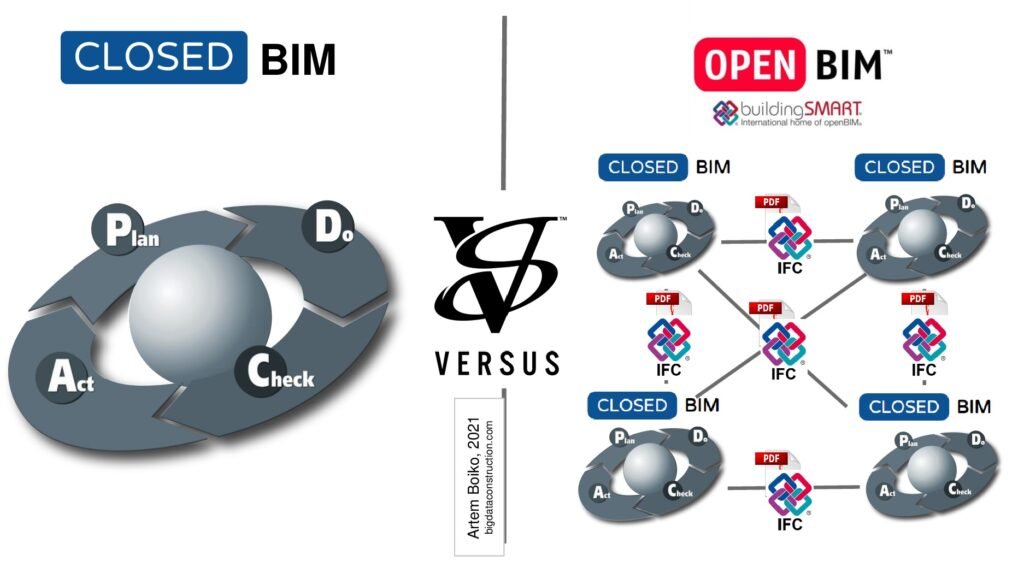
Now anyone joining this alliance of openness and internationality is committed to adhering to the standards and rules set by buildingSMART through official standardization documents. At the same time, those who did not join the association, today in some countries will not be able to participate in the bidding for supplies, because he will not even be able to apply for participation without recognition of the national standard and will be considered an unreliable partner.
As in the case of Autodesk, the organization with the beautiful name buildingSMART practices de jure persecution of those who disagree with the ideology of using the unreliable IFC format. Monopoly industry cartel with local affiliates, inflated price tag for illusory advantages, dictatorship of rules and standards, and persecution of dissent. All these problems can be avoided by formal membership in the organization with an entrance fee, which starts with an annual membership of several tens of thousands of dollars.

Thus, if you do not have a few tens of superfluous thousands, then, unfortunately, you will not be able to participate in the discussion of this world “open” technology openBIM. No money, no honey.
After the rebranding in 2005, all European manufacturers of local programs enter buildingSMART, which with the expansion of Revit, losing customers every year, now find a way to fight Revit – in lobbying for openBIM interests. From this moment, active lobbying of the interests of the openBIM concept begins at the government level in those countries where this lobbying is possible.

Fortunately for the German branch of buildingSMART, by this time there were already about 5,000 lobbyists in Berlin who were ready to help lobby the interests of German companies, concerns, as well as individual industries. Of these, 778 lobbyists have direct access to the Bundestag, and they certainly do not visit the Bundestag to visit the library. 10% of them (since construction accounts for 10% of GDP) are about 80 lobbyists who are engaged in promoting the interests of specific companies associated with the construction industry.
Take the billion dollar insulation market in Germany as an example of a typical lobbying scheme in the construction industry.
This example (article from welt.de from 2014) shows how, for decades, large corporations, like BASF, have lobbied for the use of different types of insulation in all possible areas of construction: both where it was needed and where it was unreasonably. As a result, from such active lobbying and, as a result, from new legislative initiatives that affected all construction projects in the country, only the construction industry and manufacturers of insulation materials were the only winners, who are silent about the damage to the economy, common sense and the environment. Thanks to the journalists and independent researchers who have written a large number of articles and reports on this “destructive lobbying” topic.
Baton relay in this area are now taken up by German manufacturers of software. Software vendors with outdated interfaces and know-how from the 80s, like Autodesk, are unable today (“thanks” to the creation of excellent infrastructure in the 90s) to create new technologies and software. But in order not to lose their place in the billion dollar CAD market in Europe, through lobbying their interests and legislative initiatives, they offer European governments to open a new era of design in Europe under the auspices of openBIM.

Although corruption can be considered to some extent the social glue of society, in this case, under pressure from lobbyists specifically in the construction industry, the situation begins to resemble work in a planned economy. Where it is not the wild jungle of the free market that determines the movement and development of entire industries, but where lobbyists put plans on the government to implement their business models in order to maintain a place in the building materials market and the CAD software market, thereby hindering the advancement of technologies and the development of an entire industry.
How lobbying works in practice?
Take, for example, infrastructure construction in Germany. One of the main players in this market is a joint stock company with one hundred percent state participation – German Railways (Deutsche Bahn). Deutsche Bahn, one of the largest construction contractors in Germany in the mid-2000s, notices new epoch-making technologies from Autodesk and creates tools and libraries of elements for rapid design, which leads the company in a short time into the new world of BIM technologies and tools that are used in new products Autodesk.
But local CAD software makers see this rapid development in the design level as a threat to their business. Even 20 years ago, before the Internet era (and in some regions even today), they brought to the people information about new technologies and new CAD programs through books, magazines, newspapers and software vendors who toured from company to company, telling about “ new technologies ”for a percentage of sales.
Thus, by the end of the 90s, due to the lack of modern products from Autodesk and due to the lack of transparency in access to information, local CAD manufacturers felt comfortable in the European market and cared little about competition.

But with the advent of new technologies from Revit and “BIM ideas”, European manufacturers have to find new ways to stay in the CAD software market. For this, the IAI organization is being revived, which after 2005 becomes more European. Now, thanks to lobbied legislative initiatives with the support of ministries, large German companies with state participation are turning towards joint work using buildingSMART methods. And the whole situation with the development of construction now stands on the rails of the openBIM concept.
Also, in addition to this, in the contracts there are references (without documentary evidence) that those who become a contractor are required to have several specialists in the company who understand and accept the principles of openBIM and who are ready to work on the principles of “openness”, then is, in fact, to conduct their work on the project through the exchange of information in the IFC format.
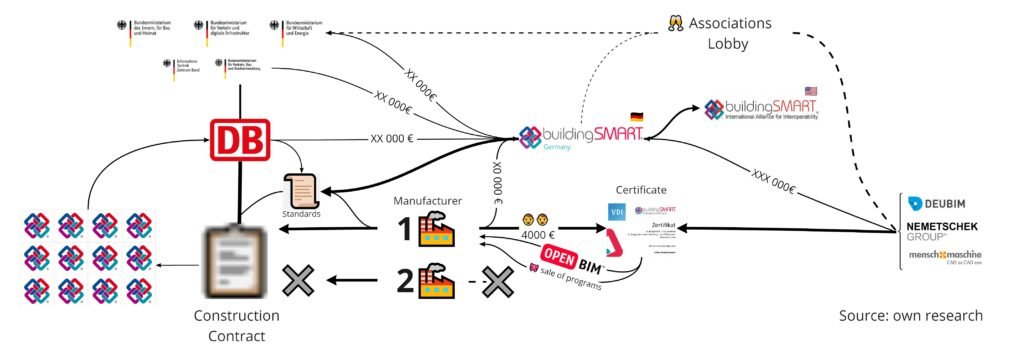
As a result, companies are forced to send their specialists and managers to a two-day webinar to obtain an important buildingSMART certificate, without which companies cannot receive the required order. This purely theoretical webinar for 2 thousand euros explains the ideology of openBIM and the importance of working with projects through the exchange of data in the IFC format using a variety of programs and abbreviations (ger .: AIA, BAP, MVD, LOI, LOG, IDM, BVB PIM, LIM, PIA, LIA, OIA, bsDD), and also neatly points out the advantages of “some programs” in the design using this method. This is followed by an exam, where the basic concepts that are needed to work with a zoo of programs based on the openBIM concept are tested.
As a result, this strategy of lobbying the interests of openBIM and the bureaucratization of processes leads Germany today in a specific industry to a “planned economy” and to the fact that in Germany the percentage of construction projects in which BIM is used is at the lowest level in Europe, amounting to only 20 %. Moreover, in the northern countries of Europe, the number of projects using BIM is over 60%.
As a result, today the openBIM concept wins in a single country and, as a consequence, in the whole region of Europe.
In addition, I compared the data on BIM technology spread in Europe with the popularity of the search term “Revit” between 2004 and 2020.
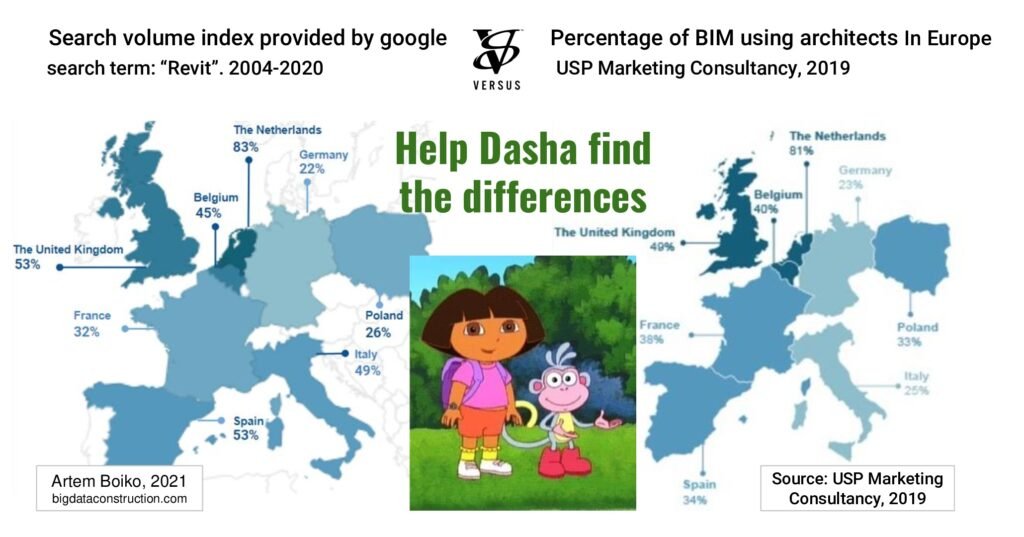
How this concept looks on a construction site can be seen from a dozen huge infrastructure projects – long-term construction. On average, the increase in the cost (and construction time) of large infrastructure projects in Germany amounts to billions of “extra” euros, which were not initially correctly taken into account when planning the project.
The most problematic of them was the capital airport in Berlin (BER), which was designed in the early 2000s and was planned to be built in 3 years. The initial commissioning of the object was scheduled for 2011, but in the end the construction lasted 14 years and the object was commissioned in October 2020. At the beginning of the design of the BER project, BIM technologies were only in their infancy, but it can be logical to assume that before commissioning in 2020, a single project model based on the openBIM concept was still formed.

In my subjective opinion, one of the main problems in such projects (on the graph) was poor design and insufficient detailing of the project model, which was formed by the beginning of construction.
All additional cost in such large projects accumulates already during the construction process due to unaccounted for elements, collisions, poor design and everything that the designers could not take into account at the start of construction. Later, all these changes amount to millions of euros, spent on changes and troubleshooting. Subjectively, I think that it is difficult to talk about poor management and organization here, but rather, it is necessary to raise the question of methods of designing and detailing models in projects.
The topic of lobbying individual interests is well complemented by a quote from an interview (in the newspaper “Handelsblatt”) with the icon of German industry – Martin Herrenknecht (the creator of tunnel boring shields), who answered a question about the development of infrastructure projects in Germany:
700 members of the Bundestag lead independent lives and have little to do with the real everyday life of citizens. I am very worried about the state of affairs in infrastructure construction in Germany. It gets very serious.
In conclusion
Since the inception of integrated construction, the main driver and reason for the growth of the entire industry has been the fact that small fragments of the project are worked out and built by small companies, which allows a large number of intermediaries to earn money through intermediation and obtaining subcontracts. And the main contractor, who distributes individual pieces of construction among his subjects, this makes it possible to live off kickbacks and opaque outsourcing of work.
Overcoming such a standard bureaucratic system is possible only through the automation of processes and transparency of prices for work and materials, which can only be helped by a “truly open and transparent” data exchange format, and not quasi-solutions from cartel organizations in the form of a closed RVT and not completely open IFC format.

And who of us today is willing to voluntarily give up speculation in prices and kickbacks?
Perhaps (no sarcasm), to our happiness, it is corruption and kickbacks that are the glue of the economy and our society as a whole today ?!
The buildingSMART and Autodesk monopolies today are a direct reflection of the interests of their charges – the construction community. That is why the construction industry in general and design bureaus in particular cannot complain about their dictatorial rulers (Autodesk & co.) If they themselves, at their level, today are not ready to go into full socialism and agree to transparent work through standardized classifiers and transparent prices for work and materials.
Every nation deserves its fate. Every country has the government it deserves.
Joseph de Maistre
Should the state be concerned with control and regulation issues? Of course not. The construction industry must start changing from the bottom up.
I would like to add that, thanks to cheap money from pension and state funds, the power of corporations and organizations lobbying for specific interests is growing in a parabolic progression not only in individual countries, but also in the world. Five major corporations are under the management of the same investment funds: Warburg, BNP, Blackrock (see the map diagram: BIM development map) and they cease to conflict and “interfere” with each other. Such huge amounts accumulate in the bank accounts of these corporations that they are able to absorb any startup and technology in any country in the world and on any terms. And if you do not agree to sell the development or stop respecting the rules of this game, the license simply will not last or the account on the platform through which the work is going will simply be disabled.
But the boomerang of history will one day return the natural balance in the construction industry to zero: monopolies will collapse and an era of transparency in data exchange will come. Regardless of whether we are ready for it or not. A little more about this in the next part.
In the construction industry, this era will come when all possible information on the project will not be delayed by individual companies in the construction chain (which earn only from storing and transmitting this information), but if this information is stored and transmitted automatically and transparently into a single project model. And this is not a fantasy: such a process of creating an information model is already possible today, and some individual companies manage to work according to this concept.

Whether this full-scale transition to transparency for everyone in the construction industry takes place after this or after the next major crisis, it doesn’t matter, today we still have to choose which program to use and which concept and monopolist should join.
What concept to choose for developers and specialists who today create new programs and technologies – closedBIM or openBIM and what is real BIM – I will try to answer in the next article. Read more about this in the fifth part.

🙇 I express my deep respect to all the individuals, developers, firms and corporations mentioned in this article. Thank you very much for your work and for the products you have gifted to the world.
🤝 I would be glad to receive your comments, clarifications and criticism.
🙋♂️ Thanks for sharing the article.
The main events tree will help you follow the information presented in this article. To add a comment to this diagram or to consider in more detail individual fragments of the map, follow the link: BIM development map from 1980 to the present
✋🏼 I’m looking to new сontacts: https://www.linkedin.com/in/boikoartem/


